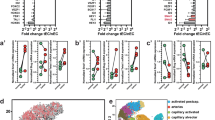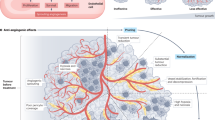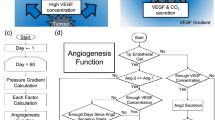Abstract
Vasohibin-1 (VASH1) was isolated as a negative-feedback regulator of angiogenesis expressed in endothelial cells (ECs). There are two transcripts of VASH1, that is, the full-length VASH1A consisting of seven exons and the splicing variant VASH1B consisting of four exons. Here, we compared the effects of VASH1A and VASH1B on tumor angiogenesis. When ECs were transfected with VASH1A or VASH1B cDNAs, VASH1B transfectants, but not VASH1A ones, induced autophagic cell death of ECs. With sonoporation, the VASH1A or VASH1B gene were transfected specifically in ECs of tumor vessels in mice. Both VASH1A and VASH1B decreased tumor vessel density and inhibited tumor growth. VASH1A normalized the remaining tumor vessels, increased their rate of perfusion, decreased tumor hypoxia and enhanced the efficacy of anticancer chemotherapy, whereas VASH1B pruned tumor vessels without causing normalization, increased tumor hypoxia and tumor necrosis and did not enhance the efficacy of anticancer chemotherapy. The alternate transfection of mice with the VASH1A and VASH1B gene showed the highest effects on antitumor activity and normalization of tumor vessels. Our present findings on VASH1A and VASH1B should provide an innovative approach that would improve the efficacy of antiangiogenic cancer therapy by balancing vascular normalization and pruning.
This is a preview of subscription content, access via your institution
Access options
Subscribe to this journal
Receive 12 print issues and online access
$259.00 per year
only $21.58 per issue
Buy this article
- Purchase on SpringerLink
- Instant access to full article PDF
Prices may be subject to local taxes which are calculated during checkout







Similar content being viewed by others
References
Hanahan D, Weinberg RA . The hallmarks of cancer. Cell 2000; 100: 57–70.
Hanahan D, Weinberg Robert A . Hallmarks of cancer: the next generation. Cell 2011; 144: 646–674.
Hanahan D, Folkman J . Patterns and emerging mechanisms of the angiogenic switch during tumorigenesis. Cell 1996; 86: 353–364.
Lip GY, Chin BS, Blann AD . Cancer and the prothrombotic state. Lancet Oncol 2002; 3: 27–34.
Folkman J . Tumor angiogenesis: therapeutic implications. N Engl J Med 1971; 285: 1182–1186.
Jain RK . Normalization of tumor vasculature: an emerging concept in antiangiogenic therapy. Science 2005; 307: 58–62.
Watanabe K, Hasegawa Y, Yamashita H, Shimizu K, Ding Y, Abe M et al. Vasohibin as an endothelium-derived negative feedback regulator of angiogenesis. J Clin Invest 2004; 114: 898–907.
Heishi T, Hosaka T, Suzuki Y, Miyashita H, Oike Y, Takahashi T et al. Endogenous angiogenesis inhibitor vasohibin1 exhibits broad-spectrum antilymphangiogenic activity and suppresses lymph node metastasis. Am J Pathol 2010; 176: 1950–1958.
Hosaka T, Kimura H, Heishi T, Suzuki Y, Miyashita H, Ohta H et al. Vasohibin-1 expression in endothelium of tumor blood vessels regulates angiogenesis. Am J Pathol 2009; 175: 430–439.
Shen J, Yang X, Xiao W-H, Hackett SF, Sato Y, Campochiaro PA . Vasohibin is up-regulated by VEGF in the retina and suppresses VEGF receptor 2 and retinal neovascularization. FASEB J 2006; 20: 723–725.
Yamashita H, Abe M, Watanabe K, Shimizu K, Moriya T, Sato A et al. Vasohibin prevents arterial neointimal formation through angiogenesis inhibition. Biochem Biophys Res Commun 2006; 345: 919–925.
Kern J, Bauer M, Rychli K, Wojta J, Ritsch A, Gastl G et al. Alternative splicing of vasohibin-1 generates an inhibitor of endothelial cell proliferation, migration, and capillary tube formation. Arterioscler Thromb Vasc Biol 2008; 28: 478–484.
Shimizu K, Watanabe K, Yamashita H, Abe M, Yoshimatsu H, Ohta H et al. Gene regulation of a novel angiogenesis inhibitor, vasohibin, in endothelial cells. Biochem Biophys Res Commun 2005; 327: 700–706.
Horie S, Watanabe Y, Chen R, Mori S, Matsumura Y, Kodama T . Development of localized gene delivery using a dual-intensity ultrasound system in the bladder. Ultrasound Med Biol 2010; 36: 1867–1875.
Horie S, Watanabe Y, Ono M, Mori S, Kodama T . Evaluation of antitumor effects following tumor necrosis factor-alpha gene delivery using nanobubbles and ultrasound. Cancer Sci 2011; 102: 2082–2089.
Miyashita H, Watanabe T, Hayashi H, Suzuki Y, Nakamura T, Ito S et al. Angiogenesis inhibitor vasohibin-1 enhances stress resistance of endothelial cells via induction of SOD2 and SIRT1. PLoS One 2012; 7: e46459.
Suzuki Y, Kobayashi M, Miyashita H, Ohta H, Sonoda H, Sato Y . Isolation of a small vasohibin-binding protein (SVBP) and its role in vasohibin secretion. J Cell Sci 2010; 123: 3094–3101.
Watanabe Y, Aoi A, Horie S, Tomita N, Mori S, Morikawa H et al. Low-intensity ultrasound and microbubbles enhance the antitumor effect of cisplatin. Cancer Sci 2008; 99: 2525–2531.
Loening AM, Wu AM, Gambhir SS . Red-shifted Renilla reniformis luciferase variants for imaging in living subjects. Nat Methods 2007; 4: 641–643.
Kodama T, Tomita N, Horie S, Sax N, Iwasaki H, Suzuki R et al. Morphological study of acoustic liposomes using transmission electron microscopy. J Electron Microsc (Tokyo) 2010; 59: 187–196.
Kitahara S, Morikawa S, Shimizu K, Abe H, Ezaki T . Alteration of angiogenic patterns on B16BL6 melanoma development promoted in matrigel. Med Mol Morphol 2010; 43: 26–36.
Suenaga K, Kitahara S, Suzuki Y, Kobayashi M, Horie S, Sugawara J et al. Role of the vasohibin family in the regulation of fetoplacental vascularization and syncytiotrophoblast formation. PLoS One 2014; 9: e104728.
Kimura H, Miyashita H, Suzuki Y, Kobayashi M, Watanabe K, Sonoda H et al. Distinctive localization and opposed roles of vasohibin-1 and vasohibin-2 in the regulation of angiogenesis. Blood 2009; 113: 4810–4818.
Nakamura T, Suzuki Y, Takahashi Y, Satomi S, Sato Y . Paradoxical augmentation of tumor angiogenesis combined with down-regulation of IP-10 after adenovirus-mediated transfer of vasohibin-1 gene in cancer cells. J Cancer Sci Ther 2014; 6 289–297.
Sato Y . Novel link between inhibition of angiogenesis and tolerance to vascular stress. J Atheroscler Thromb 2015; 22: 327–334.
Hou W, Zhang Q, Yan Z, Chen R, Zeh Iii HJ, Kang R et al. Strange attractors: DAMPs and autophagy link tumor cell death and immunity. Cell Death Dis 2013; 4: e966.
Ryter SW, Mizumura K, Choi AM . The impact of autophagy on cell death modalities. Int J Cell Biol 2014; 2014: 502676.
Codogno P, Meijer AJ . Autophagy and signaling: their role in cell survival and cell death. Cell Death Differ 2005; 12 (Suppl 2): 1509–1518.
Deretic V, Saitoh T, Akira S . Autophagy in infection, inflammation and immunity. Nat Rev Immunol 2013; 13: 722–737.
Sato Y . Persistent vascular normalization as an alternative goal of anti-angiogenic cancer therapy. Cancer Sci 2011; 102: 1253–1256.
Acknowledgements
This work was supported by a research program of the Project for Development of Innovative Research on Cancer Therapy (P-Direct), Ministry of Education, Culture, Sports, Science and Technology of Japan (to YS); and a grant-in-aid (24800003) from Japan Society for Research Activity Start-up (to SH).
Author information
Authors and Affiliations
Corresponding author
Ethics declarations
Competing interests
The authors declare no conflict of interest.
Additional information
Supplementary Information accompanies the paper on Cancer Gene Therapy website
Rights and permissions
About this article
Cite this article
Horie, S., Suzuki, Y., Kobayashi, M. et al. Distinctive role of vasohibin-1A and its splicing variant vasohibin-1B in tumor angiogenesis. Cancer Gene Ther 23, 133–141 (2016). https://doi.org/10.1038/cgt.2016.13
Received:
Revised:
Accepted:
Published:
Issue date:
DOI: https://doi.org/10.1038/cgt.2016.13
This article is cited by
-
Vasohibin-1 rescues erectile function through up-regulation of angiogenic factors in the diabetic mice
Scientific Reports (2021)
-
Alternative splicing in endothelial cells: novel therapeutic opportunities in cancer angiogenesis
Journal of Experimental & Clinical Cancer Research (2020)



